[ ← VIEW ALL (Pendlefolk archive - Stories from Pendle Hill) ]
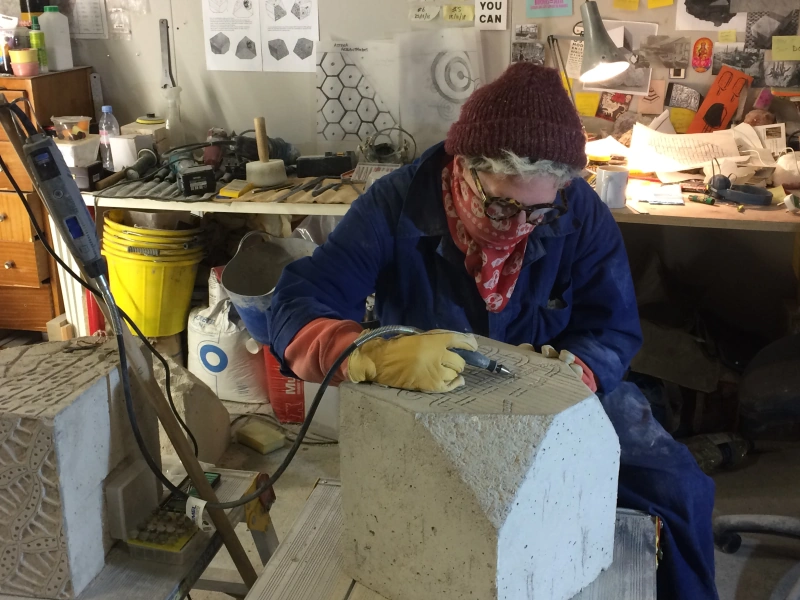
Future Archaeology: Henrietta Armstrong on humanity and the Pendle Hill summit stones
Interview by Evangeline Atkinson
Commissioned by In-Situ and Pendle Hill Landscape Partnership, multimedia artist Henrietta Armstrong was challenged to create a public sculpture to be installed at the trig point on Pendle Hill. She engraved 12 summit stones made from locally-sourced materials and each represents a different theme after months of researching local history, exploring the local landscape, and talking with local people. Henrietta describes the final result as a kind of “Future Archaeology”, leaving our mark for future generations.
Can you tell us a little about yourself, your background and your connection to working on Pendle Hill?
I’m an artist, I’m London-based at the moment. I’ve been in London for about 20 years now, I was born in Devon but moved up. I lived in and around Bath and Bristol for most of my life before that. I have a studio in Bermondsey at SET at the moment but I’ve just been accepted for a new studio at Chisenhale Art Place. They are quite sought after studios because they’ve been there since the 80s and to have a permanent studio is kind of like the holy grail in London. I’ve moved studios 3 or 4 times in the past 3 or 4 years.
I work in many different media, so just whatever fits the project. For the past few years I’ve been working mainly with ceramics and sculpture, but I started off doing drawing and painting. I get bored easily so change.
How the Pendle thing came about? I saw the opportunity come up on an email, a mailout, advertised by In-Situ. I asked Kerry, who ran In-Situ with Paul, whether it was just for local artists or if anyone could apply. She said “No, no, just go for it, try and enter something”. It was a weird thing actually because it was one of those things that kept on coming back to me. I kept on say “Oh this looks quite interesting, but no, no…” and then somebody would ask “Have you seen that, it looks right up your street?”, and I was going “Yeah… but no… I’m not sure”. I thought well the deadline is too soon and all these different things kept coming up, but then I found out that the deadline had been extended, so I thought it was a sign that I just had to send something in.
Have you done things similar to this in the past? Is there a thread that tends to bring your work together or is each project very different?
This is my first public sculpture commission but I think a lot of my work is to do with archaeology and looking at how we interpret things that have been left behind by our ancestors. I think that ties it up quite well. Also looking into the future, into what we will be leaving behind and how that will be interpreted. I’ve always been very interested in archaeology and nature. I think there is a thread but maybe it’s not an obvious thing.
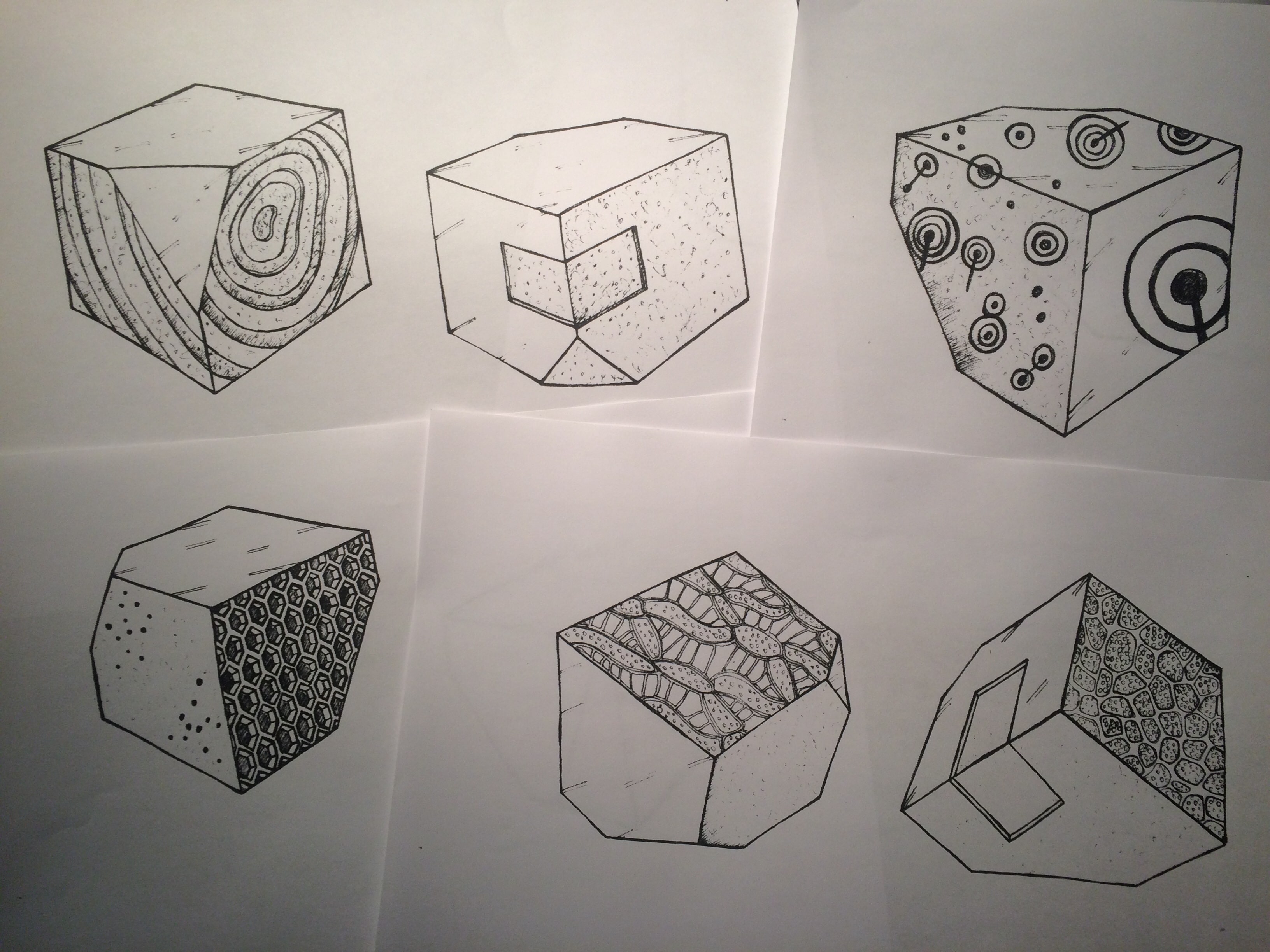
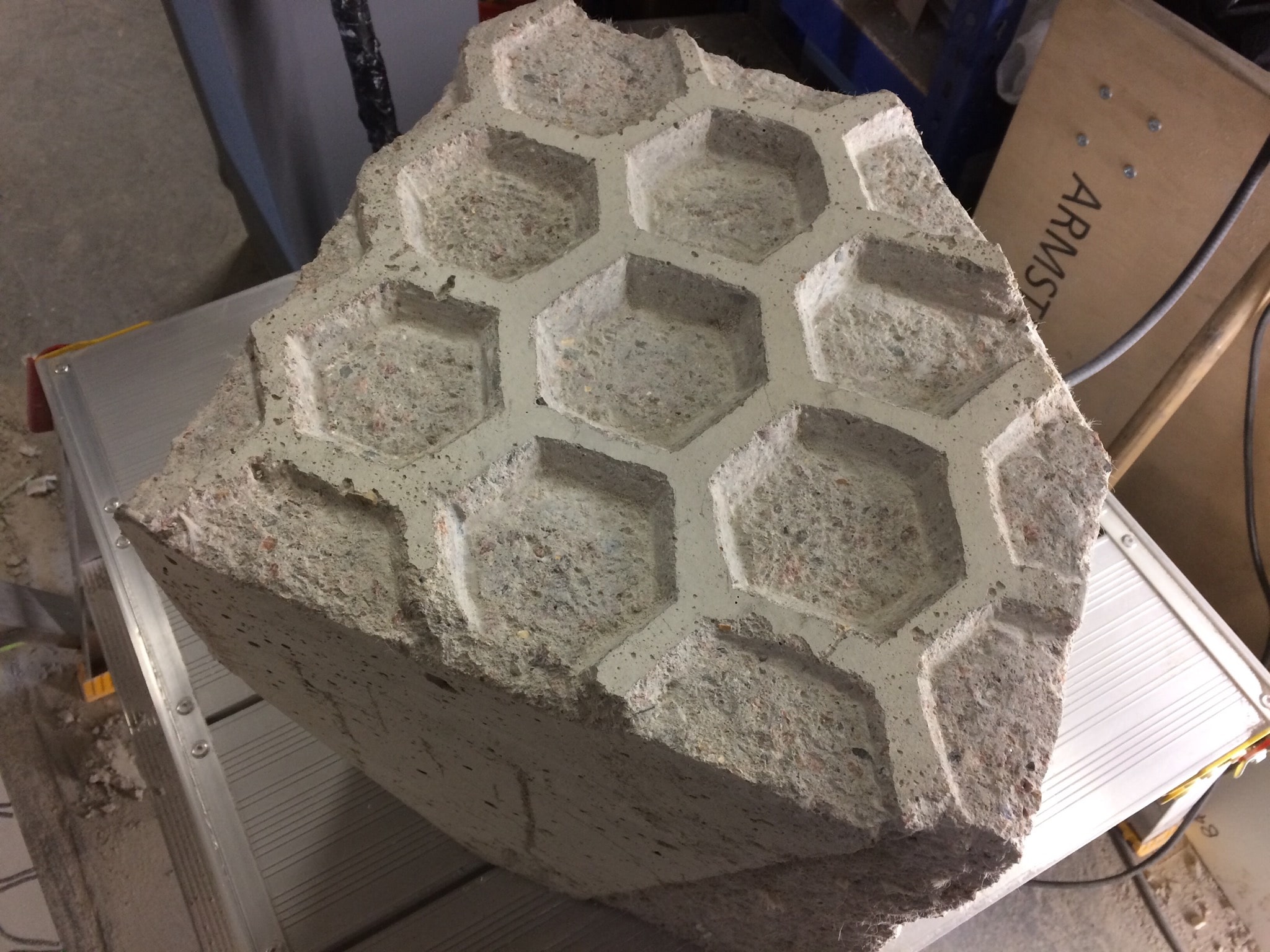
When did you start working on this commission?
I found out I got the commission in Autumn 2017. In a way I’ve pretty much been working on it since then, but officially since April 2018. Really I’ve been working on it for over a year – from the workshops, to the ideas and research, to the making.
Had you been to Pendle before? What were your first reactions?
No I hadn’t. It was just beautiful, it’s really really beautiful. I think everybody up here is lovely and working on the project I’ve made lots of good friends. Everybody I’ve come in contact with has been really nice. I think it’s funny that you can come to a place and then gradually, the more I came, the more special I realised this place is and then the more intimidated I became that what I was doing had to be special. It was a lot of pressure in the end.
I actually found out through my research, that my Grandmother went to Quaker school quite close by. I was quite moved to find out that she would have gone up and down the hill often because she was at boarding school and they would have done that for exercise. My Grandmother passed away 15 years ago but she would have been there all the time and I didn’t ever know that.
Also my mother is from Yorkshire, from Halifax which is not far away. I found out I had great great great-grandparents who had dye works there, where they dyed the Grenadier Guards’ uniforms scarlet. It’s strange how things fall into place.
So how did you approach coming up with an idea, where did you start?
Well the Pendle Hill Landscape Partnership (PHLP) wanted me to do a series of workshops and sessions to look into local people. So I just started there really, talking to people about what was special to them about the area and getting a general feel. Then I did a lot of research, months and months of research, about the area and the nature, and the cotton mill industry. I did hundreds and hundreds of designs over the months and then something gradually fell into place.
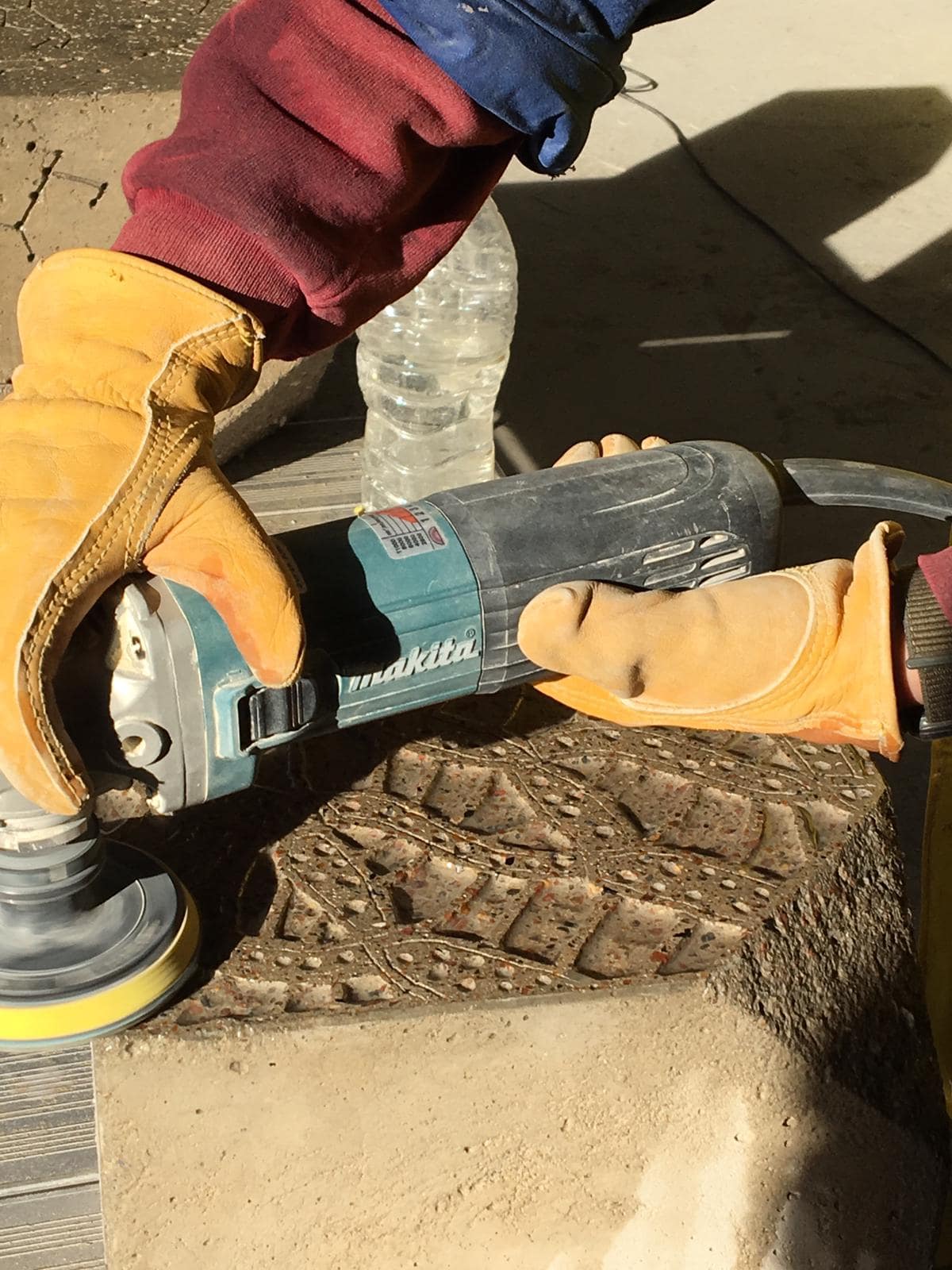
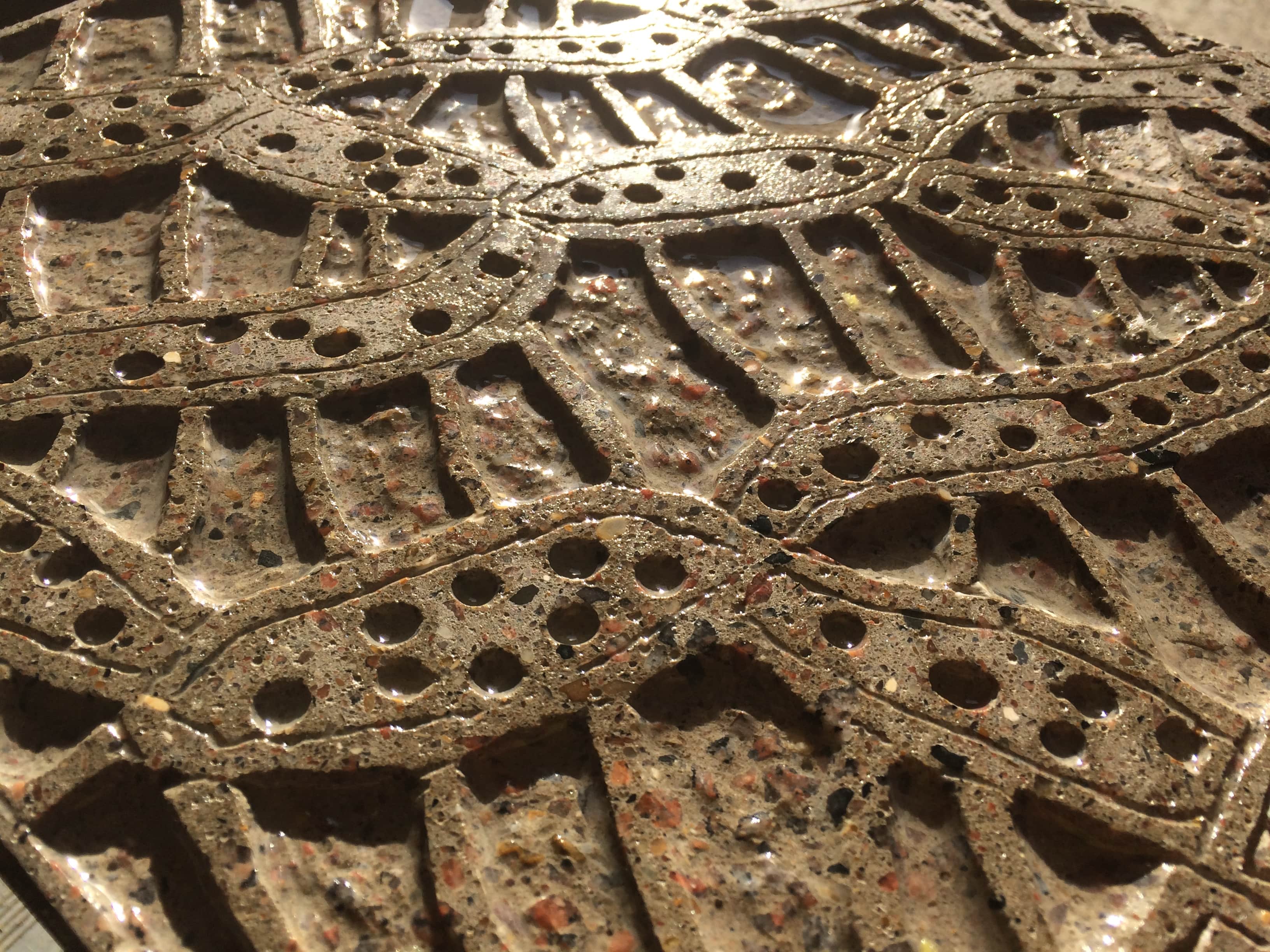
From those hundreds of ideas, how did you decide which to pursue? What’s that process like?
I think trying to understand an artist’s brain is challenging. Most people think you have an idea and then you design it and make it, but it doesn’t always make sense. I think it’s very tangential thinking that you can’t always explain. You might see something in a book or on TV and it will pop into your head. It’s kind of like putting everything into your brain and then something just comes out.
But yeah, I think at one point I was panicked thinking “What can I do that’s going to do this justice?”
Was the initial brief quite open ended of did you have strict parameters to work within?
It was quite open ended. And I don’t think that PHLP kind of knew what they wanted… or expected what they got. It’s been quite a journey for everybody because it hasn’t ended up being what it started out as.
Originally, I think they wanted a panorama pointing out other things that you can see from the top of the hill, because I know on a good day you can see Blackpool Tower. I was like well, I could do something that, like being on the Eiffel Tower and pointing things out, but the hill itself is so interesting. I would rather do something about the hill and the local people than pointing out something you can see in the distance because I think that would make more sense.
While you were developing your ideas did you come across anything that made you change direction in a big way?
I really wanted to bring in everybody because I know there are a lot of different communities. I wanted to bring in specific groups but then I thought actually there are so many different communities that you have a problem if you exclude one. You’d have to include them all. I was looking at the Radicals and I was looking at the Quakers, the Suffragists and also at the Asian community but you can’t do that and then not include others because people will get annoyed about it. So then I thought I had to bring the focus out. I sort of went in and then I had to go out to make it about people and about humanity. I think that’s easier because we have that in common at least. I wanted it to be all-inclusive rather than picking out particular groups.
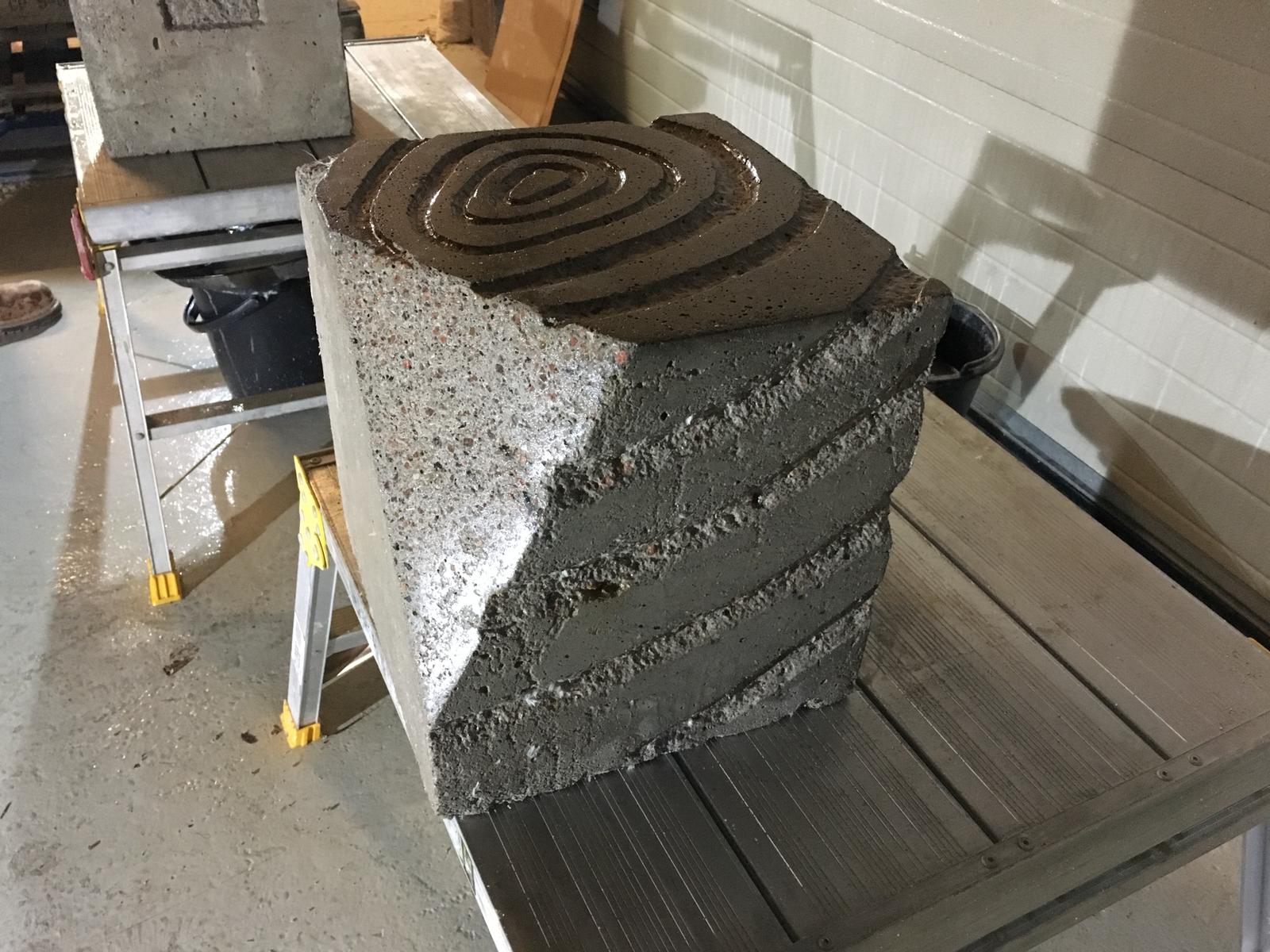
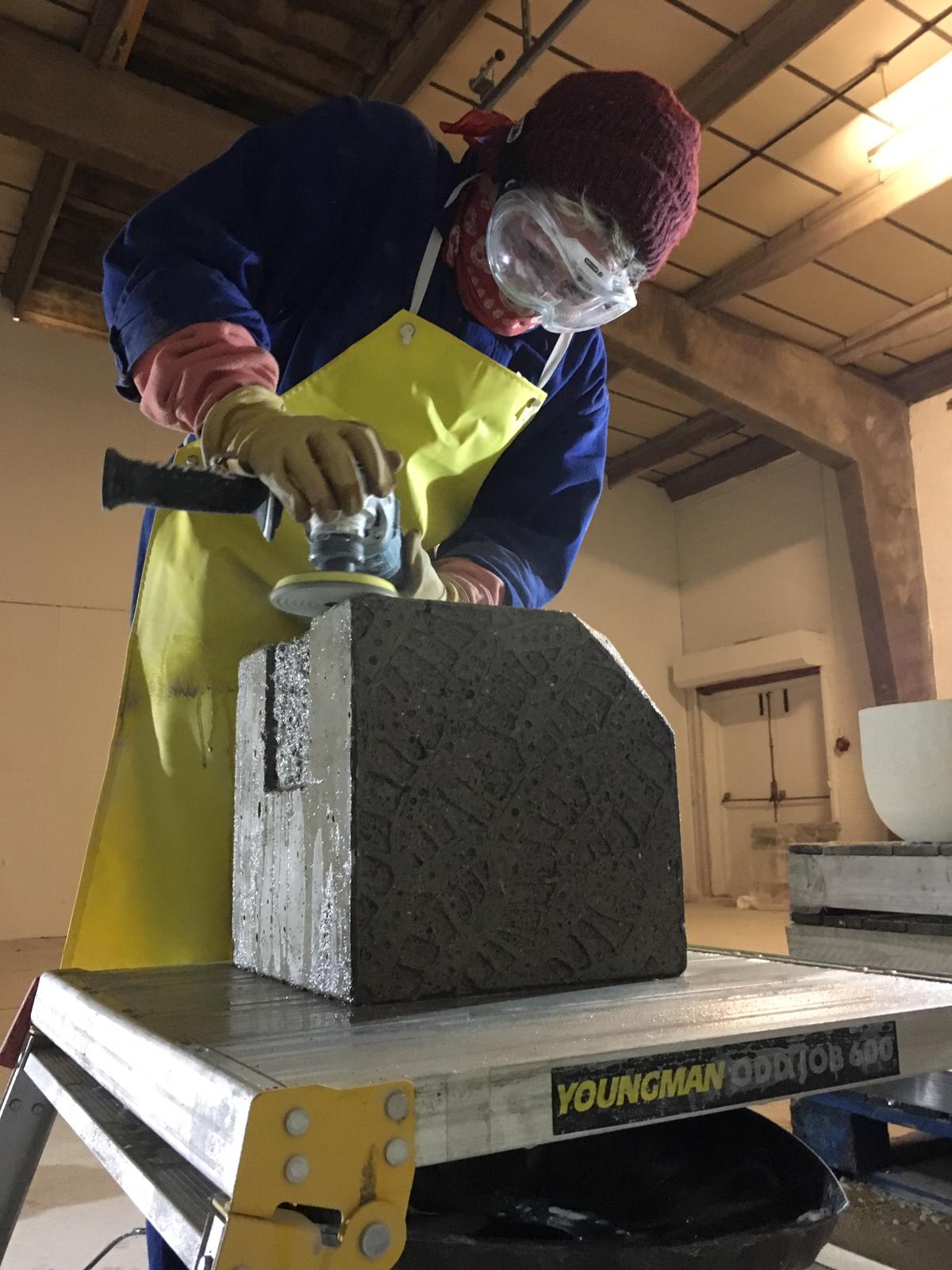
For those who haven’t seen it, how would you describe the finished article?
They’re a series of 12 stones, 4 of the stones are the directional stones, to mark North, South, East and West, and are carved from limestone. They’re slightly different. Then 8 of them have been cast out of concrete which was from a quarry at the foot of the hill. Hanson cement supplied the cement from their quarry and actually sponsored me. I carved into those, engraved 8 different designs. I chose the cube because it seems like quite an alien shape within nature but it’s actually one of the most common structures: crystalline structures in nature, like salt, all these are cubed crystalline structures. But then I’ve also taken bits off each stone so it’s about man meeting nature really. Each stone is dedicated to a different aspect of the hill and Pendle. So you have the grey concrete blocks and then the very white limestone.
Is there a connection between the stones and the ancient past of standing stones?
When I first proposed the idea I was very much thinking about having a ‘Pendlehenge’ kind of thing, but it changed. A lot of my work is about Neolithic people and the earliest people though. One of the stones is dedicated to the earliest settlers, I’ve done ring cup carvings as a sort of nod to them.
Sometimes in stone circles you have a lead stone, is one of the summit stones more important than the others?
No, they’re all just as important and they’re all around the trig. You have the directional stones but they’re actually quite simple. They all have a well in the middle, because when I first went up Pendle Hill I was looking at these piles of stones called cairns, and it really stuck in my mind. I kept thinking “Why are they doing this, what is this thing?”. I’m really interested in rituals and why humans do different things so I just kept on coming back to that. The wells are in the directional stones because the cairns that existed have been chewed up and put around the paths, and I wanted to feed into that ritual in a way that wouldn’t just encourage more piles of stones. You can take a stone up to the summit, and then pick up the stone that’s been left by somebody else in the well in one of the directional stones, leaving your stone in its place. You could even be there alone but pick up a stone and leave yours. It’s like a communication between you and the next person, or the last person.
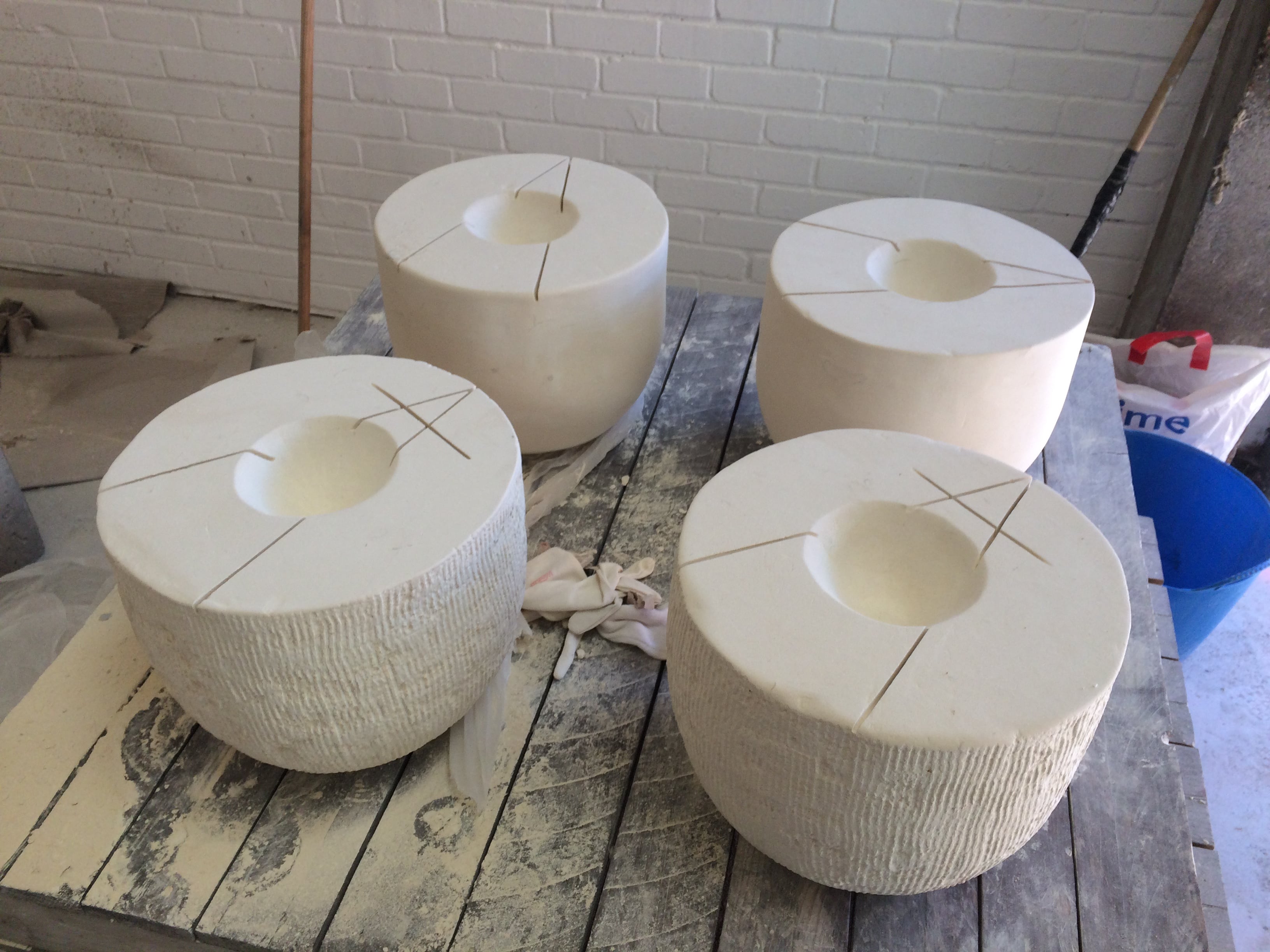
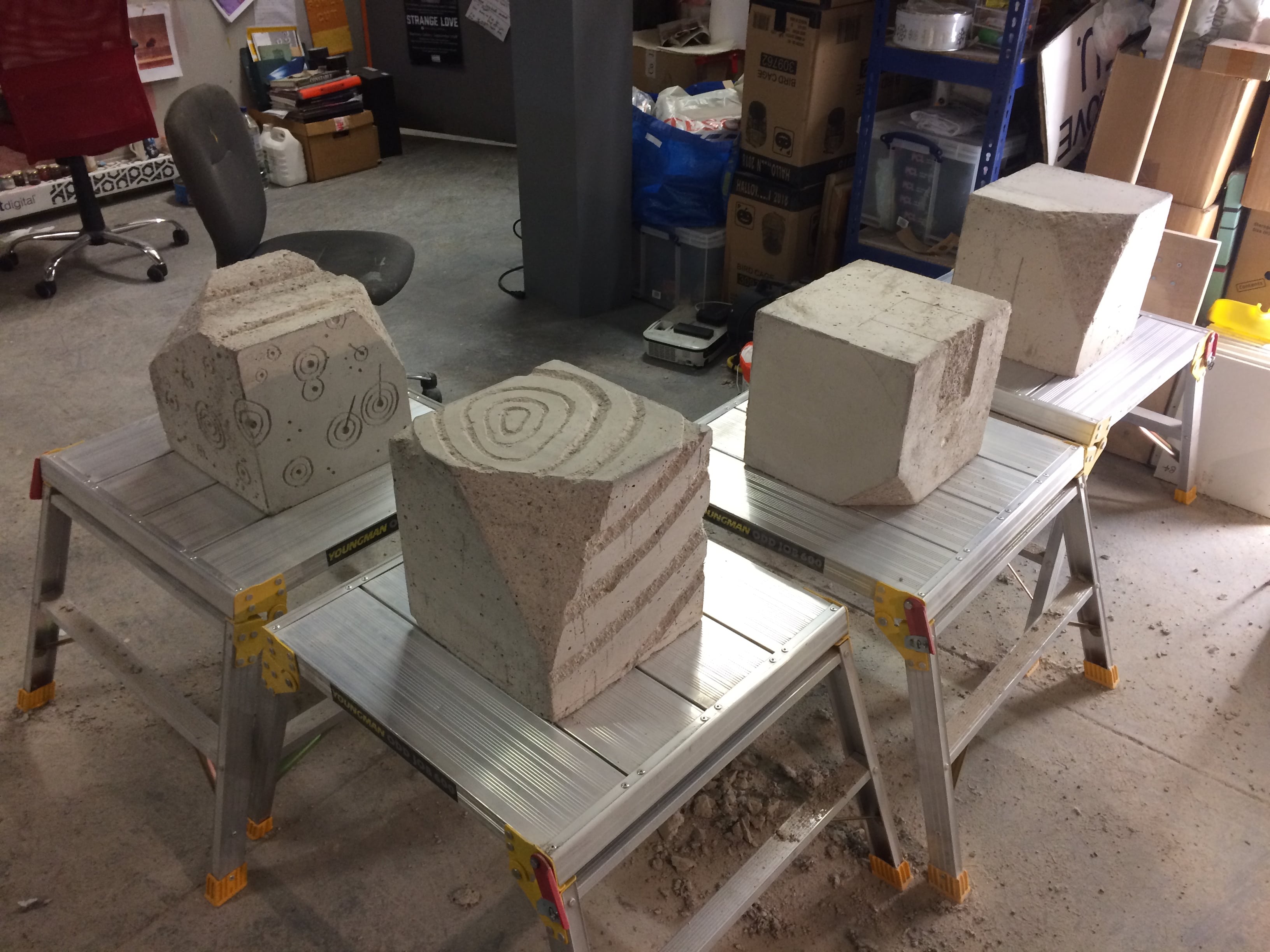
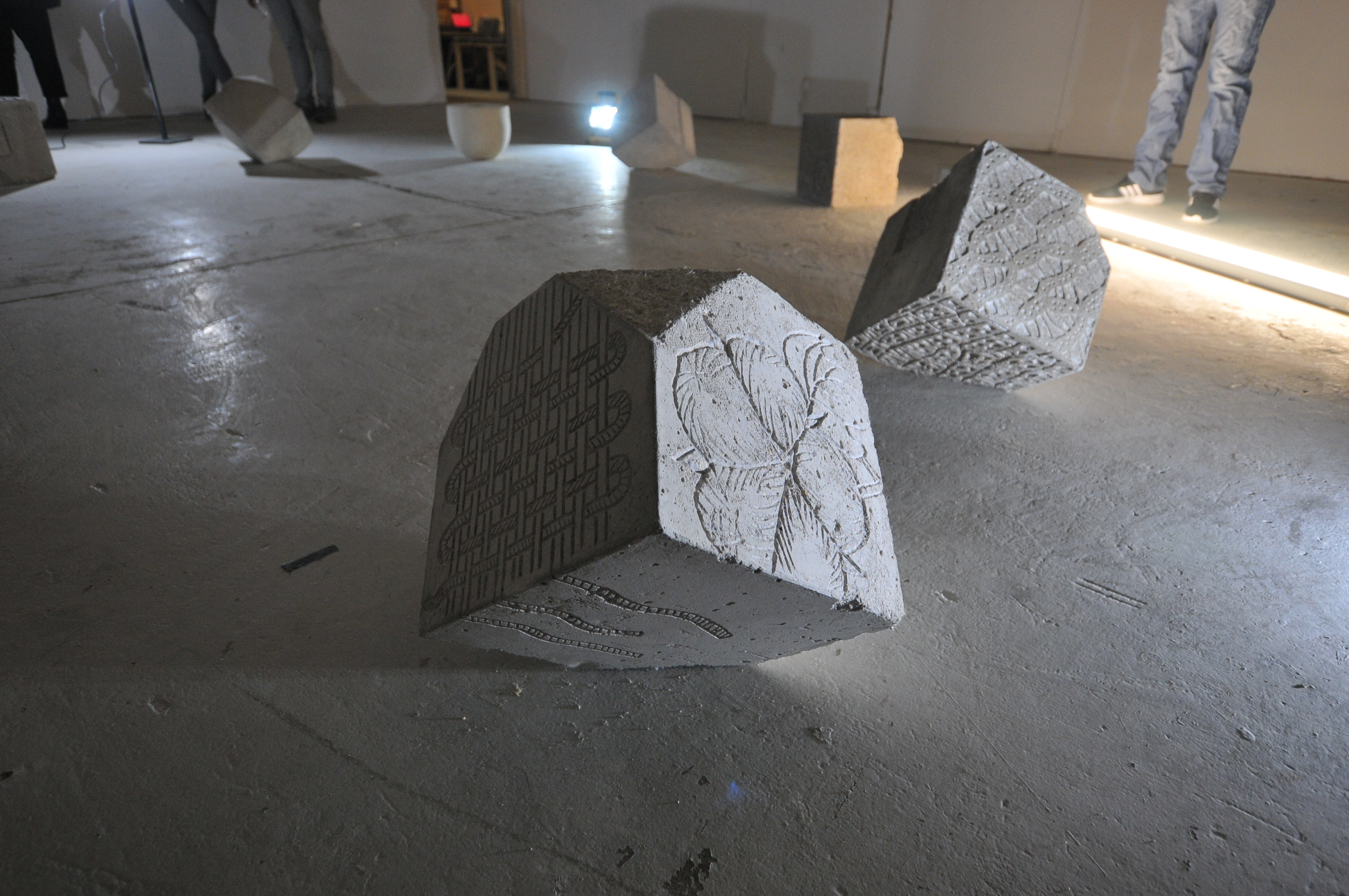
Is there an explanation of this for when people come across it on the hill? Will the background be communicated or is it there for discovery and interpretation?
I very much doubt they’ll put up a big information board because I think that would be unsightly, but I’m thinking of maybe getting some funding to write a little book to tell the story. I think there will be something on the PHLP website which will point people in the right direction and there’s also a blog on the In-Situ website which talks a bit more about it. But I also quite like the idea of it being word of mouth. It’s all about the stories and passing things on.
Before the Summit Stones were buried each of the stones were 3D scanned and there are plans with Pendle Hill Landscape Partnership to have an app so people can see what is buried beneath the surface as there are a lot of intricate carvings that you can’t see. Each of the stones was designed as a 3 dimensional object, with carvings on each surface and only 100% makes sense when you can see the whole of each stone. Through the app people will be able to see the 3D scans and move them to see all the way round each stone and find out more about the story behind the Summit Stones on their phone when they visit them. I think this is a really interesting and futuristic aspect to the work which will connect and catch the imagination of the younger generations.
I would also like to do a publication and I would probably like to do a series of prints as well, but I think I’ll have a little break first. I was speaking to my Mum the other day and she was saying “Oh I didn’t know any of this, you’ve got to write it down”. I’m going to have a bit of space and time and then I come back to it, but I think that could be quite nice with some illustrations.
With this installation you are putting something onto the hill that would not otherwise be there. How do you reconcile the introduction of something new with the natural evolution of local communities and people using the hill? If it’s discovered by archaeologists in hundreds of centuries time they’re bound to puzzle over what it meant to local people when it was created.
I was talking about this before and I said it’s sort of like archaeology in reverse, it’s leaving something that is going to be discovered by people of the future. I think again it’s coming back to humanity. If you look around where Stonehenge is in Avebury and that sort of area it’s about leaving things behind. People always like to leave their mark, it’s something that we’ve always done as humans. One of the stones has my hand print on it and I think that is the idea of connecting through touch, but also communicating, and it references the cave people wanting to leave their mark, saying “I was here”.
I think it’s all about trying to speak to people of the future and capture people’s imagination. Yes, it’s introducing something alien to a natural environment, but the trig was already there and the set stones have been there for 60 years. Nobody’s complained about that… well maybe they did at the time when the trig got put there… but because this is art I think people can get a bit riled up. It depends on people’s ideas of art and what it is.
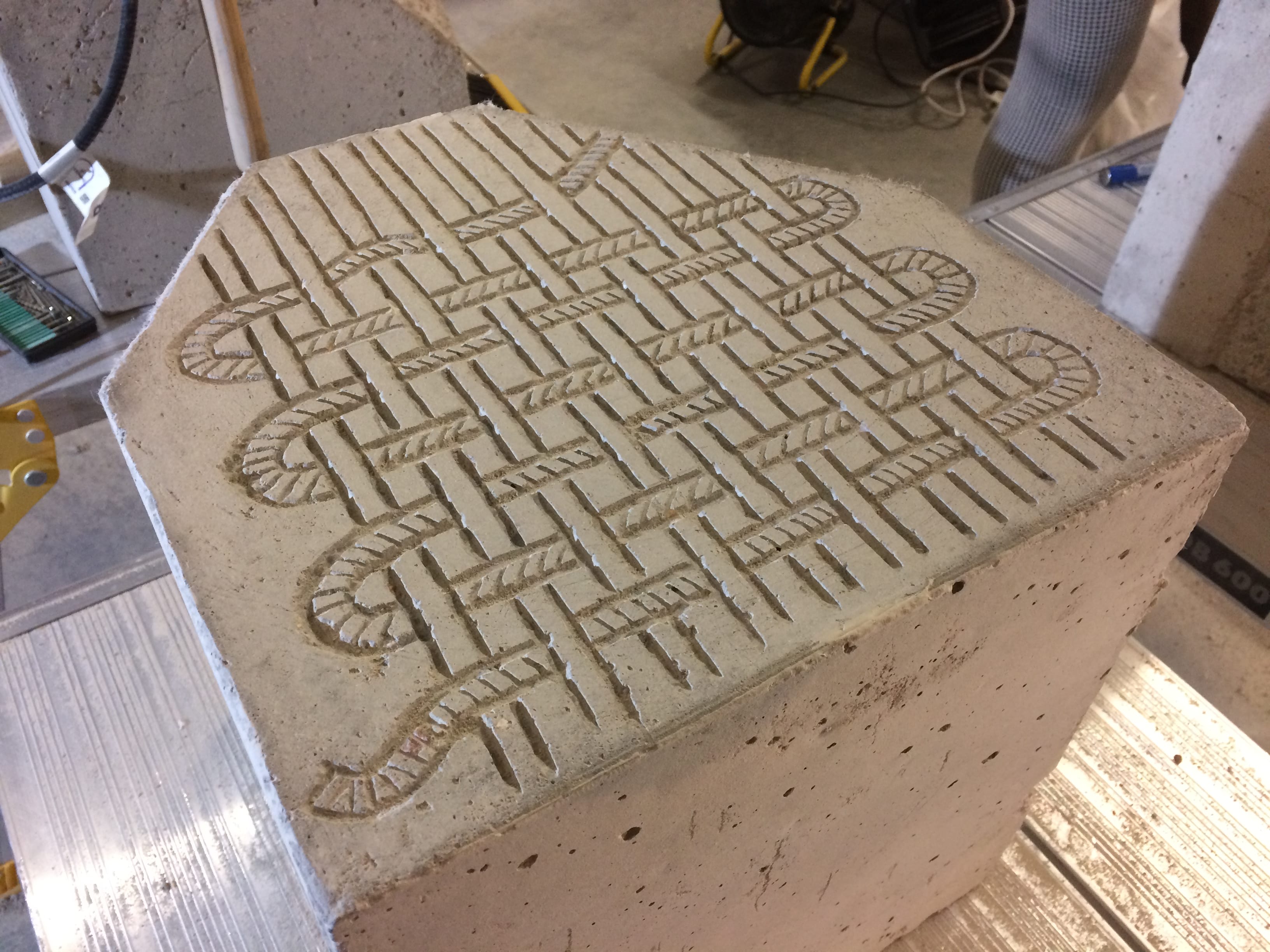
What has the response been like so far? You mentioned that Hanson supplied the materials, have local people and businesses been supportive?
Most people have been really interested. I think because it is such a special place I always expected that some people would love it, hopefully, but obviously you’re always going to get a backlash from some people. I’ve even got a friend that I know from here who didn’t know about it, I haven’t seen her in a long time, but when she found out I was doing something she was like “But it’s my hill!”. She said that as long as I didn’t do a giant pink witch then it was alright. I think everybody thinks it’s their hill.
Hanson were really great actually. I contacted them because I very much wanted those materials to be locally sourced rather than introduce something entirely alien into the environment. They sent me these two massive almost sarcophagi which were over a tonne of materials and never sent a bill. They said “No, no if you ever need any stone, that’s fine” and I thought “Wow, sponsorship for life…haha”. But no, they were great they just said to maybe put something in their newsletter.
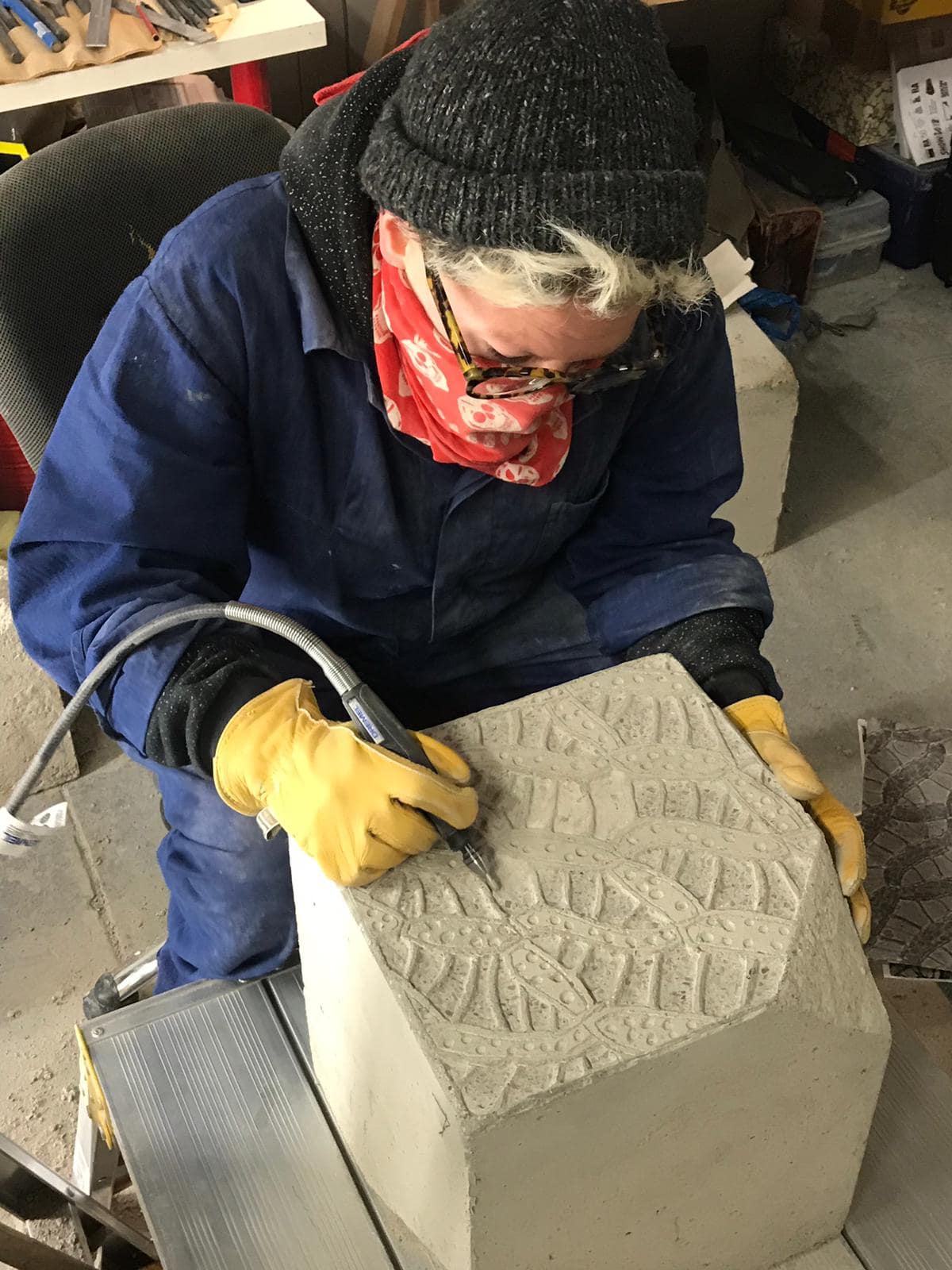
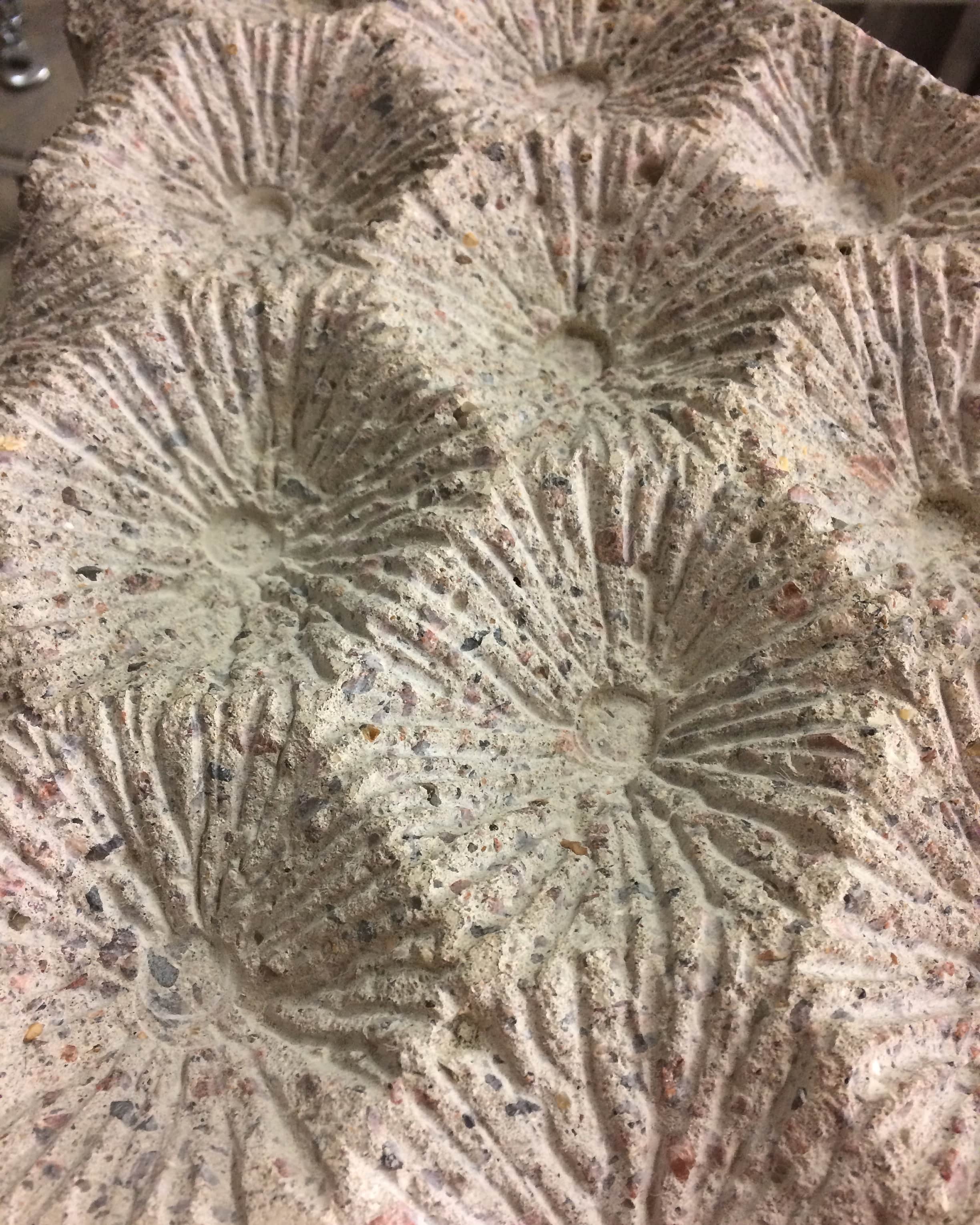
During the exhibition in February we were able to see all the surfaces of each stone but once installed the majority of the engravings are going to be buried. Are there any bits of them that you’ve deliberately hidden away to be discovered in centuries time?
Well that’s the thing, the idea behind the work is that it is like archaeology in reverse, they are being buried with the intention of being found. The main body of each sculpture is concealed underground with the idea that the ground will slowly erode around them and the stones will gradually be exposed one day to the Pendle of the future. I think something people won’t realise is that some of the stones have the most simple designs on the top surface because they have to be quite strong and obviously people have to be able to walk on them. So some of the best designs, in my mind, are going to be buried which is quite bittersweet in a way. I think I’m quite attached to them and obviously I’ve got my favourite stones that are hard to let go of. The other day I was taking them out of the van for the last time with this crane that I bought…I never thought I’d have my own crane!…and it was a bit sad. I was thinking this is the last time I’m going to do this. I’ve had lots of friends helping me and I’ve been very lucky with people getting interested. Some friends have said “I’ve got the day off tomorrow, can I come and help you in the studio?” and I’ve just put them to work on stuff. A lot of people have been involved in doing different things and I quite like that. There’s a lot of love that’s gone into these things.
You mentioned there is a stone that commemorates the Neolithic aspect, which other themes do the stones represent?
So you’ve got one stone which is referencing the cotton industry, and that’s got the warp and weft on one surface, and a cotton plant on another. They’ve all got different decorative references. Then you’ve got a stone that has geological lines which are the contour lines of the hill. There’s one stone which has constellations on it and the moon. That’s about how important the moon is to plants as much as the sun, because it controls the water and does special things. But also, it’s sort of just about making us realise that we are quite small and insignificant really if you think about the bigger picture.
You’ve also got the fossil stone that’s got a nautilus fossil engraved on top of it, different fossils that you would find in this area, and a carving of a particular coral that would have been around here. Millions of years ago this area would have been under water which is why you find these fossils in the stone.
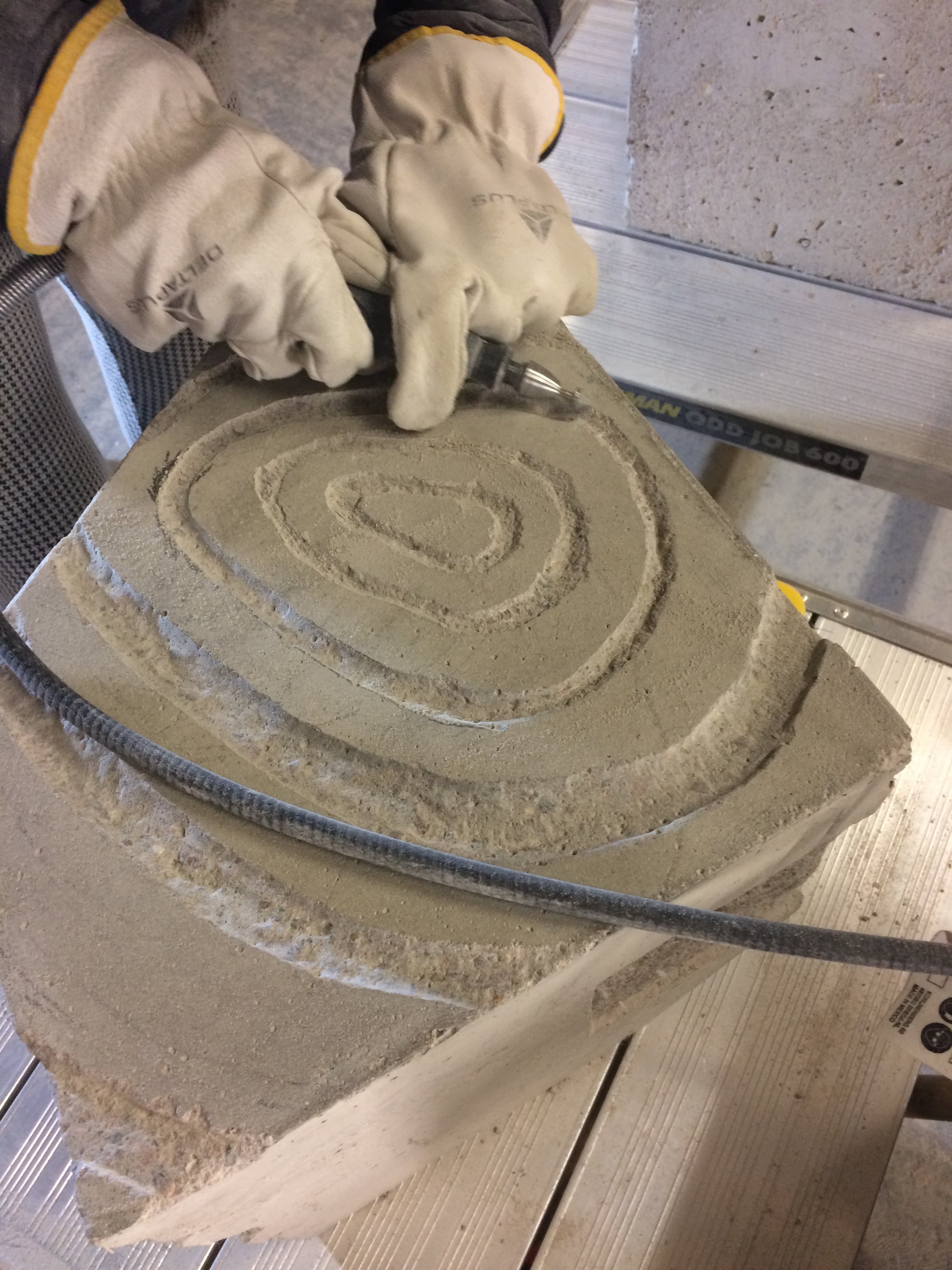
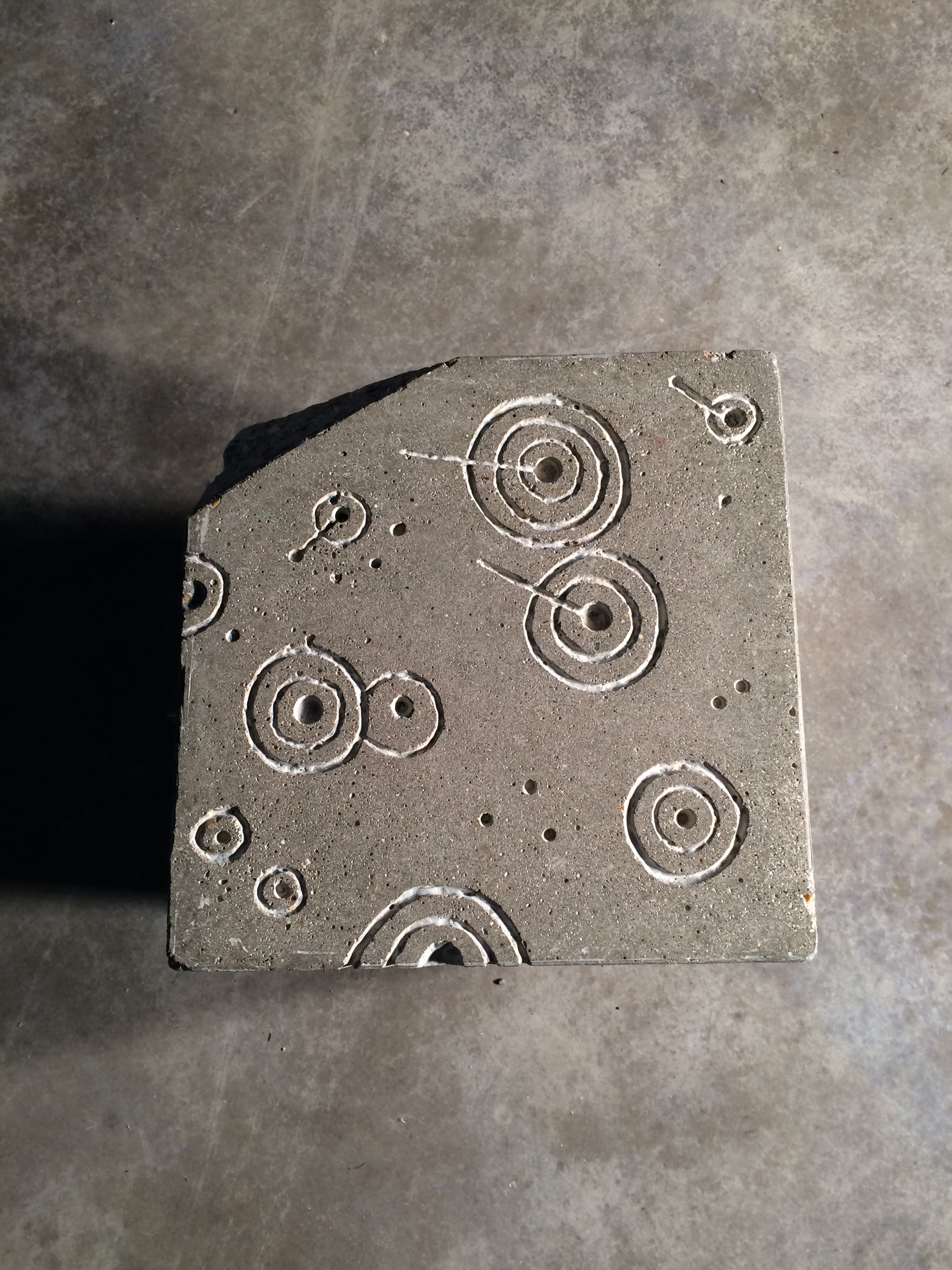
And those fossils are found in the limestone that was quarried to make the cement. How about the other stones?
There’s a communication stone. It was going to be the communication stone and then it was going to be the Radicals, but in the end I reverted back. It’s got a soundwave on it, which is actually my voice recorded and put through a particular software. It’s me saying “home” because when I spoke to people from Pendle, one of the things that everybody kept on saying was “When I see the hill, I know I’m nearly home”. I thought that was quite nice, and that’s also got a handprint on it. It’s my hand, which is actually quite small, so maybe I should have done it a bit bigger. Another stone is dedicated to the Sphagnum moss which is obviously from the peat on the hill and is so important. You’ve got two surfaces with two different views of how the cells look under the microscope.
There was supposed to be a message carved underneath them but I realised that the message would actually probably get destroyed on the concrete as they were putting them in place, so I put it inside the stones instead. The message is “Don’t be afraid of change, embrace things that are different”, which is something that kept coming up and I really thought about when I was talking to different people. It stuck out as what people would want to say to the future. I want that to be passed on, like a word of mouth sort of myth, so it’s embedded into the stones.
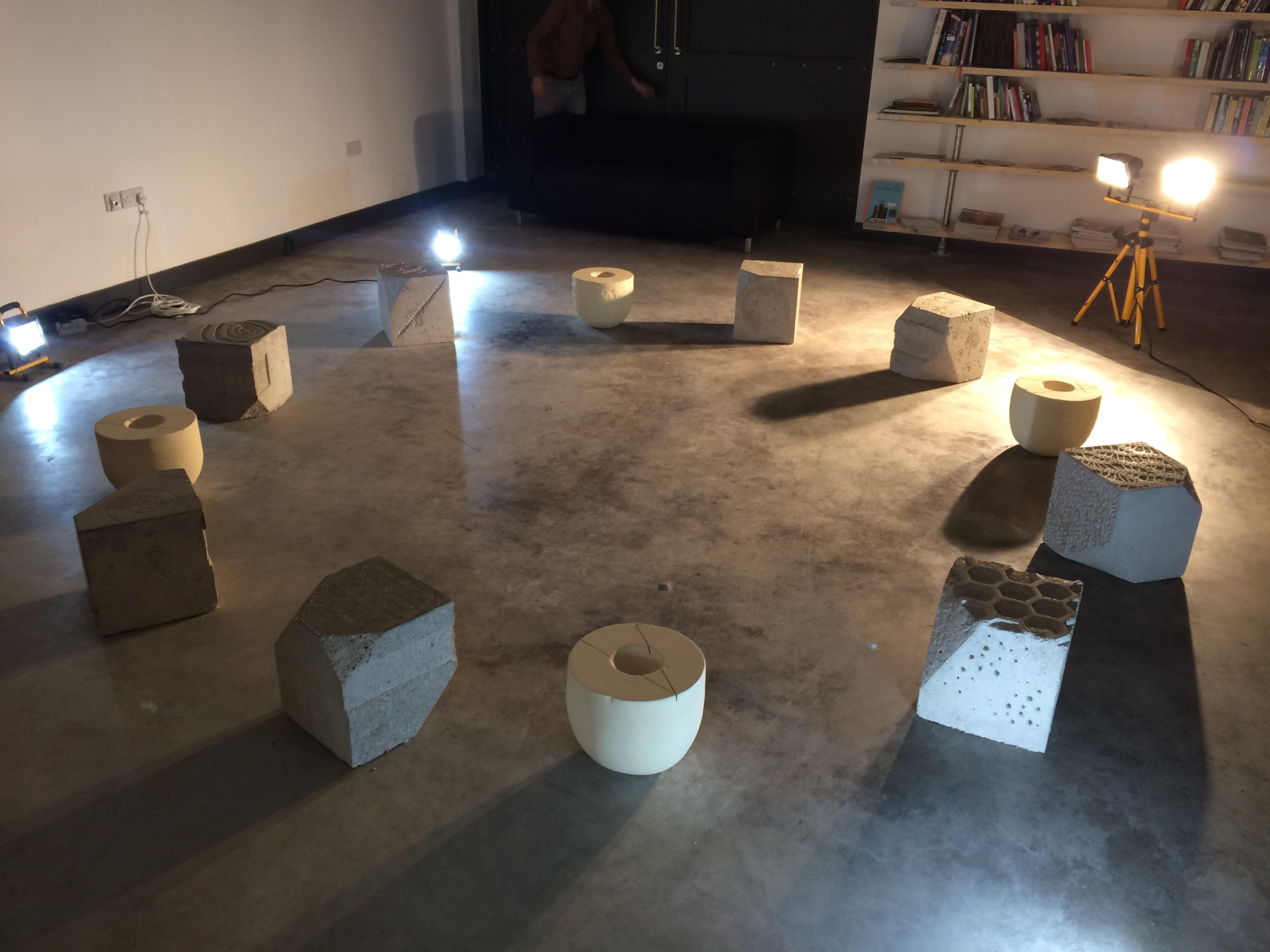
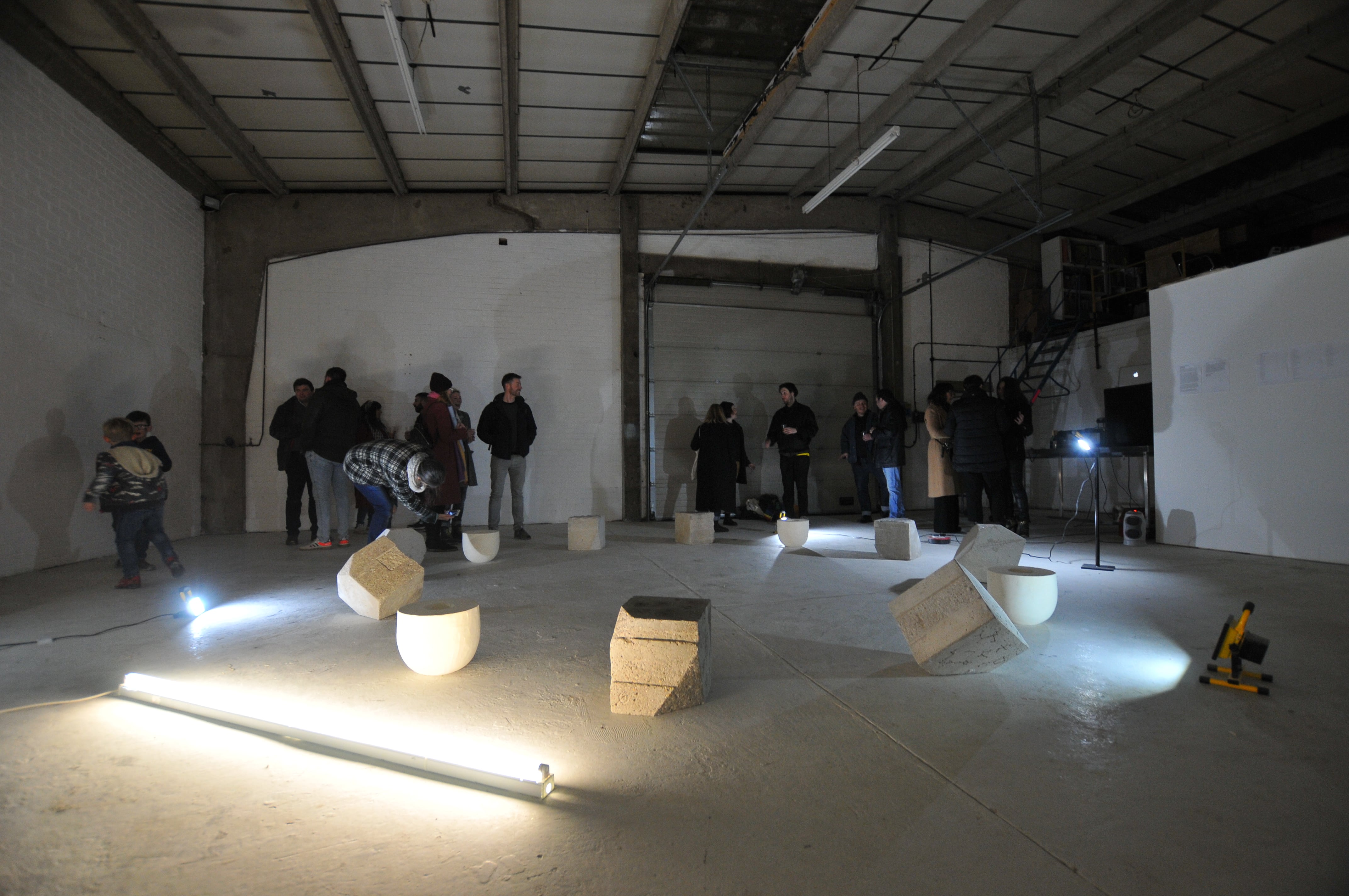
Did you encounter any particular technical challenges when making the stones?
I think it’s one thing when you’re designing something but then suddenly I realised the weights I would be dealing with. Each of the stones weighs about 60 kilos. My brother’s a personal trainer, he’s very strong, and I was thinking that him a couple of friends could just lift them but then I realised that wouldn’t work. It’s been quite interesting learning how to handle that kind of weight. You need straps and a lot of very strong equipment to do it safely which was quite a challenge.
There’s been so much process in doing the whole project. The eight that are from concrete I cast by hand and I think even my brother was saying I’m mad. I could have put everything into the cement mixer and just done it all in a day but I really felt that I wanted to work with the materials and I wanted to mix everything by hand.
I could only physically do two a day. It was quite strenuous but I felt like I should do that work and put the effort in. It’s been a lot of learning but it’s been good… using a lot of angle grinders is scary. The amount of research I did and the amount of learning, I really felt like I’d done a PhD in concrete! It’s trying to show people the beauty of it. Some people started sending me photographs of bollards and things like that because suddenly their eyes were open to the beauty of concrete! Like “I saw this and thought of you”.
Do you think you would work with concrete again?
Yeah I have some plans at the moment to do some more concrete things. I think the next work I’ll be doing will be with sculpture, maybe a mix of sculpture and ceramics.
Especially now the sponsorship’s in place…
I think I’ll be doing a series of sculptures but not that big! I was very very lucky because where I made them, the studio’s very accessible as there’s a yard and it’s all on one level. But my new studio is on the second floor so I couldn’t have actually done it there.
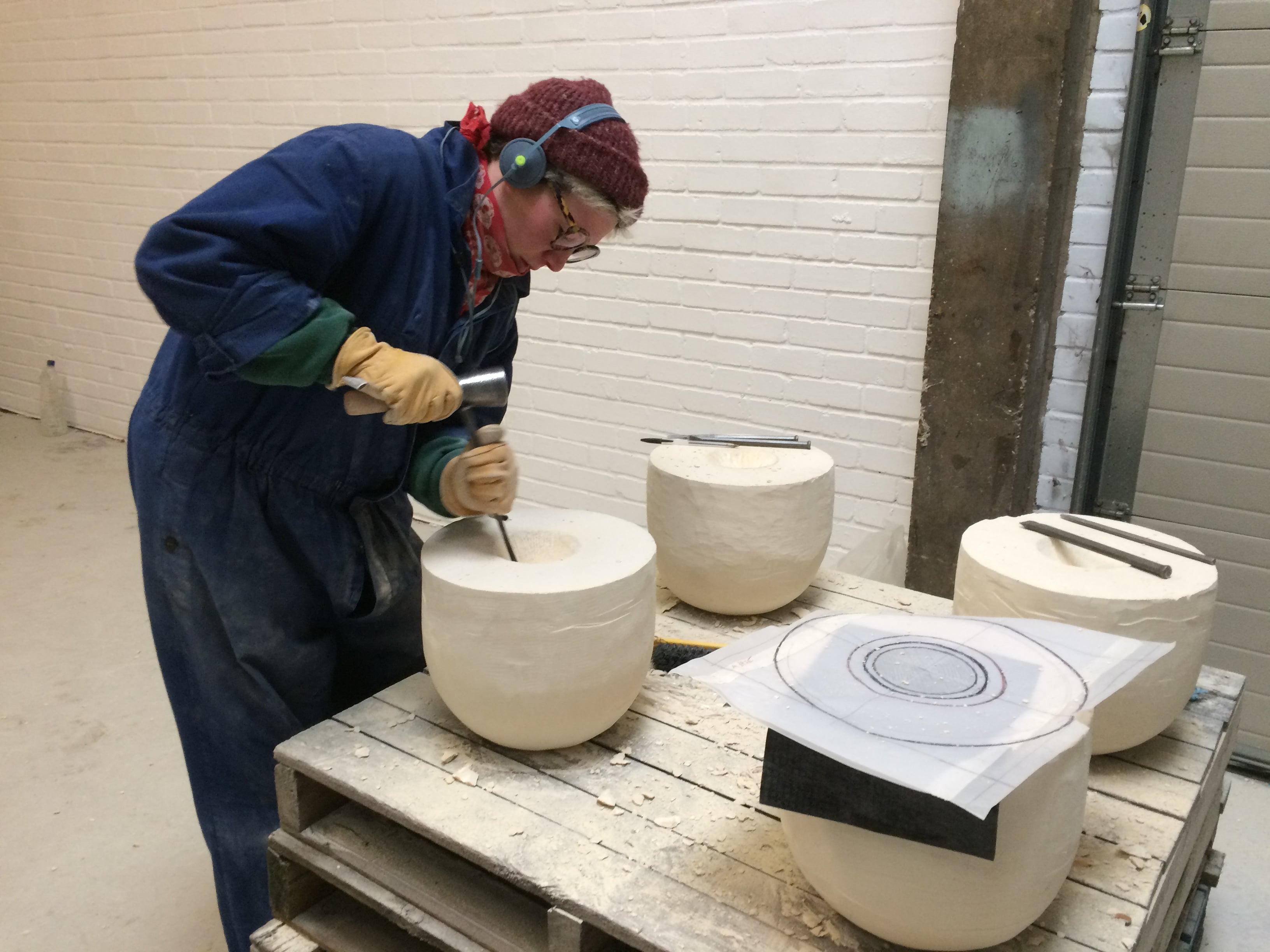
Apart from the concrete do you think there’s anything else you’ll take from this project?
I’ll definitely come back. I think I’d really like to do some more things here. There’s a lot of really great work that In-Situ are doing and a lot of community things that are going on. I’ve been really impressed by that, it’s really exciting. Listening to some of the things that PHLP do, some of the different sessions they do with nature, I was thinking “Aw if I lived here I would definitely get involved”. It would be really interesting doing the hedging and I wanted to come and have a go at the dry stone walling that people were doing. There are some really fun things that they do and even today, I went up to Aitken Wood to see the sculptures and it was so beautiful up there.
And finally, when will it be officially installed and ready for people to visit?
The exhibition finishes on Saturday and then I’m going to prepare them ready for installation. It’s all weather dependent and dependent on the contractor being available who’s going to be taking them up the cart track to the top of the hill. They’ve been doing a lot of work up there with the peat restoration and repair of the paths. I haven’t got an official date but they’ll be in place within the next couple of months.